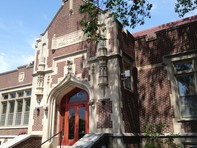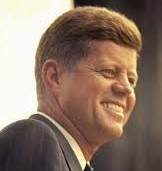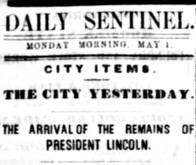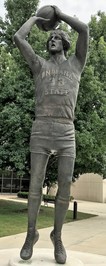March 21 – March 27The Week in Indiana History |
|||||||||||||||||
“I don’t know if I practiced more than anybody, but I sure practiced enough. I still wondered if somebody, somewhere, was practicing more than me. – – – Larry Bird Did You Know?   Andrew Carnegie was not a Hoosier. He was born in Scotland and lived his life in eastern states. However, the steel magnate left a lasting impression on Indiana. 164 impressions, to be exact. That’s how many public libraries Carnegie gave to Hoosiers.  As a matter of fact, Indiana has more Carnegie libraries than any other state. In the early years of the 20th Century, the Carnegie Corporation provided funds for 1,679 public libraries in towns and cities around the United States.       Ladies’ book clubs, school groups, and civic organizations joined forces across America to apply for Carnegie funds. The building was paid for, but communities were required to provide a suitable tract of land and establish a tax that would generate funds for maintenance of the building once it was constructed.            The first Carnegie Library in Indiana was in Goshen, dedicated in 1903. The last ones were built in Lowell and North Vernon in 1918. During that 15-year span, thousands of Hoosiers were introduced to their own neighborhood libraries. No fee was to be charged for a library card, and Carnegie insisted that books be placed on open shelves so that readers could browse on their own.       Carnegie Libraries were built to stand the test of time. Made of brick, limestone, and marble, they were designed by leading architects. They were constructed in a variety of styles, including Italian Renaissance, Spanish Colonial, Beaux-Arts and Classical Revival.            A survey a few years ago found that 145 Indiana Carnegie Libraries are still standing. Approximately 100 of those are still in use as libraries. Others have been converted into public meeting halls, restaurants, bookstores, and residences.            Andrew Carnegie once said, “A library outranks any other one thing a community can do to benefit its people. It is a never- failing spring in the desert.” ANSWERS: 1. Tulip Poplar tree 2. Wabash River 3. Lake Monroe 4. McCormick’s Creek State Park |
|||||||||||||||||



 1910   The Carnegie Corporation approved a $30,000 grant for the construction of a public library in Vincennes. The offer was increased to $35,000 when a suitable lot was procured at the corner of Seventh and Seminary Streets. Local architect J. B. Bayard designed the structure in the style of Collegiate Gothic Revival. The library was dedicated in 1919 and continues to serve the reading public after more than a century.
1910   The Carnegie Corporation approved a $30,000 grant for the construction of a public library in Vincennes. The offer was increased to $35,000 when a suitable lot was procured at the corner of Seventh and Seminary Streets. Local architect J. B. Bayard designed the structure in the style of Collegiate Gothic Revival. The library was dedicated in 1919 and continues to serve the reading public after more than a century. 1919   A group of farmers got together at the Claypool Hotel in Indianapolis to organize the Indiana Federation of Farmers’ Association. Their goal was to promote farming and agricultural programs and issues. John G. Brown of White County was elected the first president of the organization, along with a 10-member board of directors. Now known as Indiana Farm Bureau, the association serves all 92 counties.
1919   A group of farmers got together at the Claypool Hotel in Indianapolis to organize the Indiana Federation of Farmers’ Association. Their goal was to promote farming and agricultural programs and issues. John G. Brown of White County was elected the first president of the organization, along with a 10-member board of directors. Now known as Indiana Farm Bureau, the association serves all 92 counties.


 1951   Mary Rieman died in Indianapolis at the age of 92.  She was one of the last surviving witnesses to the funeral of Abraham Lincoln at the Indiana Statehouse. At the age of six, she was with her family on April 30, 1865, when the Lincoln funeral train arrived in Indianapolis. She had clear memories of standing in the cold rain with thousands of others as they made their way into the Statehouse rotunda to view the body of the fallen President. Pictured: The headline from the Indianapolis Daily Sentinel for May 1, 1865. Â
1951   Mary Rieman died in Indianapolis at the age of 92.  She was one of the last surviving witnesses to the funeral of Abraham Lincoln at the Indiana Statehouse. At the age of six, she was with her family on April 30, 1865, when the Lincoln funeral train arrived in Indianapolis. She had clear memories of standing in the cold rain with thousands of others as they made their way into the Statehouse rotunda to view the body of the fallen President. Pictured: The headline from the Indianapolis Daily Sentinel for May 1, 1865.  




